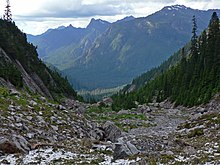Stillaguamish
The Stillaguamish or Stillaquamish are a Native American tribe living in what is now Washington State . Its official name is The Stillaguamish Tribe of Washington . At the time of the first encounter with Europeans, his villages stood on the river of the same name and its tributaries between the Skagit and Snohomish Rivers . Today most of them live in Snohomish County .
Culturally, they belong to the coastal Salish and are closely related to the Skagit , Snohomish and Sauk-Suiattle . Marriage relationships also existed with tribes in Oregon and California .
The name "Stillaguamish" is derived from a word that means river people or people from the river.
history
Early history
The Stillaguamish, like most coastal Salish, were only permanent in winter. At least 29 villages can be identified. During the warmer months of the year they were hunting and fishing in their traditional area. According to their tradition, this area comprised around 300,000 acres on the Stillaguamish River between Stanwood east and Darrington .
Southwest of Darrington was a main meeting place of the Upper (Upper) Stillaguamish, the Lower (Lower) Stillaguamish gathered more between Silvana, Trafton, Milltown, Hazel and Florence.
Samuel Hancock was probably the first white man to sail the Stillaguamish River together with the Indians in 1850 and, as it was believed to be a military operation, was initially received hostile. Hancock saw that in the 300-inhabitant village one of the chiefs put a cross, from which contacts to missionaries can be derived. In 1857 the Jesuit Eugene Casimir Chirouse actually exercised considerable influence with them. In 1850 they had few rifles and knew no revolvers. At that time, women still wore belts made from the fibers of trees, which are known as "cedars". The number of dogs was considered a measure of a woman's wealth.
The men hunted mountain goats in the nearby Cascade Mountains and sold their skins to neighboring tribes or to the British who they visited in Victoria on Vancouver Island . Their livelihood, however, was salmon, along with berries, roots and marine animals.
Their houses were plank houses supported by totem poles . Several families lived together in them. Their light summer huts were wooden frames covered with plant fiber mats.
Smallpox, assimilation, treaty with the US
The first contact with whites changed the way of life. So they began to grow potatoes, and soon they also worked for whites in harvesting or clearing.
The tribe consisted of 150 to 200 people in 1853. The number was probably considerably higher a little earlier, as many of them were likely to have fallen victim to the 1853 smallpox epidemic .
In the Treaty of Point Elliott , the Stillaguamish had to cede their land to the USA in 1855.
Struggle for recognition
On January 8, 1970, the Indian Claims Commission recognized that the tribe had been stripped of their land in 1855. In compensation for the loss of 58,600 acres of their traditional land, they should receive compensation of $ 64,460. After deducting the payments already made, $ 48,570 was paid out.
The tribe was neither recognized nor did it have a reservation. On October 27, 1976, he achieved a status approaching that of a tribe and enjoyed the appropriate rights. The year before, on July 4th, they had marched with the national flag upside down in the parade commemorating the founding of the state to draw attention to the lack of recognition. One of their leaders was Chief Esther Ross.
Todays situation
In 1984 the tribe had 156 members. He runs a small fish factory and a casino on Jim Creek . The Stillaguamish Festival of the River has been held every year in August since 1990 .
literature
- Robert H. Ruby / John A. Brown: A Guide to the Indian Tribes of the Pacific Northwest , University of Oklahoma Press 1992, pp. 224-226.
- William Whitfield: History of Snohomish County, Washington , Evansville 1979
Web links
- Website of the Stillaguamish Tribe of Indians
- Stillaguamish Tribe of Indians. Natural Resource Department
- Angel of the Winds website
